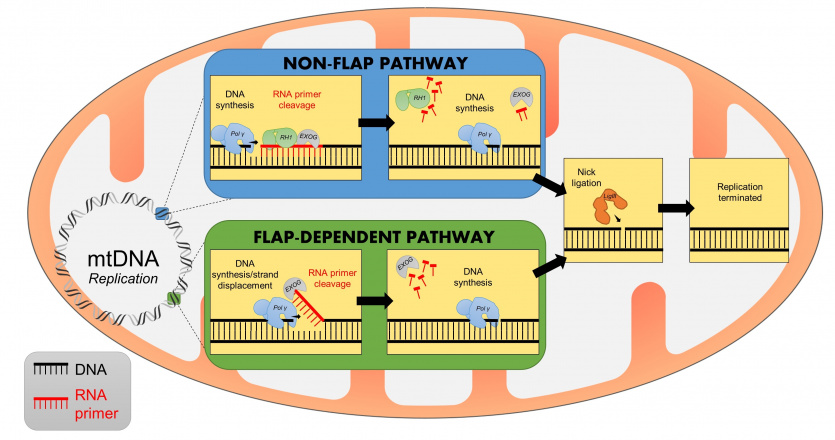A paper by the team of dr hab. Michał Szymański, prof. UG on RNA primer deletion and DNA end formation has been published in the prestigious journal Nucleic Acids Research. Co-authors of the publication include MWB UG and GUMed Dean dr hab. Ewelina Król, prof. UG.
In recent months, the group of scientists led by prof. Michał Szymański has enjoyed several successes. In December 2021, the team received an extension of the European EMBO grant for a further two years with funding increased from €50,000 to €100,000 per year. In February 2022, prof. Michał Szymański received the EMBO YOUNG INVESTIGATOR SMALL GRANT award from the same organisation.
Nucleic Acids Research
On July 12, 2022, an article entitled 'In vitro reconstitution reveals a key role of human mitochondrial EXOG in RNA primer processing' was published in the Oxford University journal Nucleic Acids Research. - 'Thanks to our findings, we have created a model of possible pathways that lead to the removal of RNA primers and the termination of the DNA replication process in human mitochondria,' - reports prof. Michal Szymanski's team.
The authors of the paper are Anna Karłowicz, Andrzej B. Dubiel, Jolanta Czerwińska, Adela Bledea, Piotr Purzycki, Marta Grzelewska, Ryan J. McAuley, Roman J. Szczęsny, Gabriela Brzuska, Ewelina Król, Bartosz Szczęsny and Michał R. Szymański.
For their research, prof. Michał R. Szymański's laboratory has collaborated with the European Research Council (ERC Starting Grant), the Foundation for Polish Science (FNP), the National Science Centre (NCN), the European Molecular Biology Organisation (EMBO) and the Ministry of Education and Science.
Group leader prof. Michal R. Szymanski has spent most of his scientific career in the USA. There, he completed his studies, obtained his PhD and received a grant for further research. This research has contributed to understanding the mechanisms of DNA replication and repair in bacteria, the structural basis of human mitochondrial DNA replication, and describing the causes of toxicity and complications associated with the use of antiviral drugs.
In 2017, after receiving POLONEZ grants from the National Science Centre and FIRST TEAM grants from the Foundation for Polish Science, he started working as an assistant professor in the Team of Specialised Laboratories at the Intercollegiate Faculty of Biotechnology of the University of Gdańsk and the Medical University of Gdańsk. Currently, prof. Michał R. Szymański is Head of the Department of Molecular Biology at the Faculty of Biotechnology, University of Gdańsk.
We congratulate the team on the publication and wish them further achievements.
You can read the entire article here.
A few words from the team and dr hab. Michal R. Szymanski, prof. UG on the discovery:
The removal of RNA primers is essential for mitochondrial DNA (mtDNA) replication. Several nucleases have been implicated in RNA primer removal in human mitochondria, however, no conclusive mechanism has been elucidated. Here, we reconstituted minimal in vitro system capable of processing RNA primers into ligatable DNA ends. We show that human 5′-3′ exonuclease, EXOG, plays a fundamental role in removal of the RNA primer. EXOG cleaves short and long RNA-containing flaps but also in cooperation with RNase H1, processes non-flap RNA-containing intermediates. Our data indicate that the enzymatic activity of both enzymes is necessary to process non-flap RNA-containing intermediates and that regardless of the pathway, EXOG-mediated RNA cleavage is necessary prior to ligation by DNA Ligase III. We also show that upregulation of EXOG levels in mitochondria increases ligation efficiency of RNA-containing substrates and discover physical interactions, both in vitro and in cellulo, between RNase H1 and EXOG, Pol γA, Pol γB and Lig III but not FEN1, which we demonstrate to be absent from mitochondria of human lung epithelial cells. Together, using human mtDNA replication enzymes, we reconstitute for the first time RNA primer removal reaction and propose a novel model for RNA primer processing in human mitochondria.

